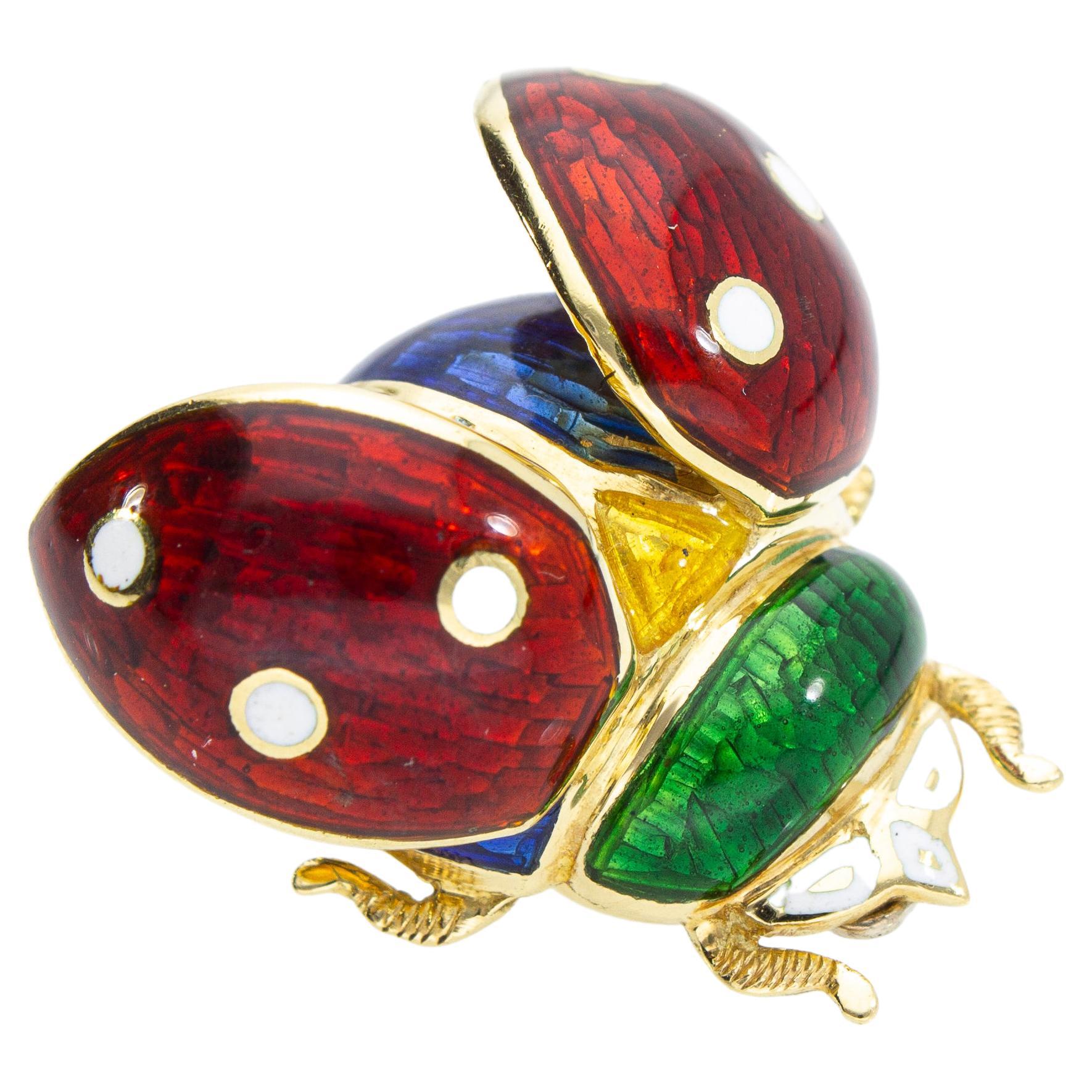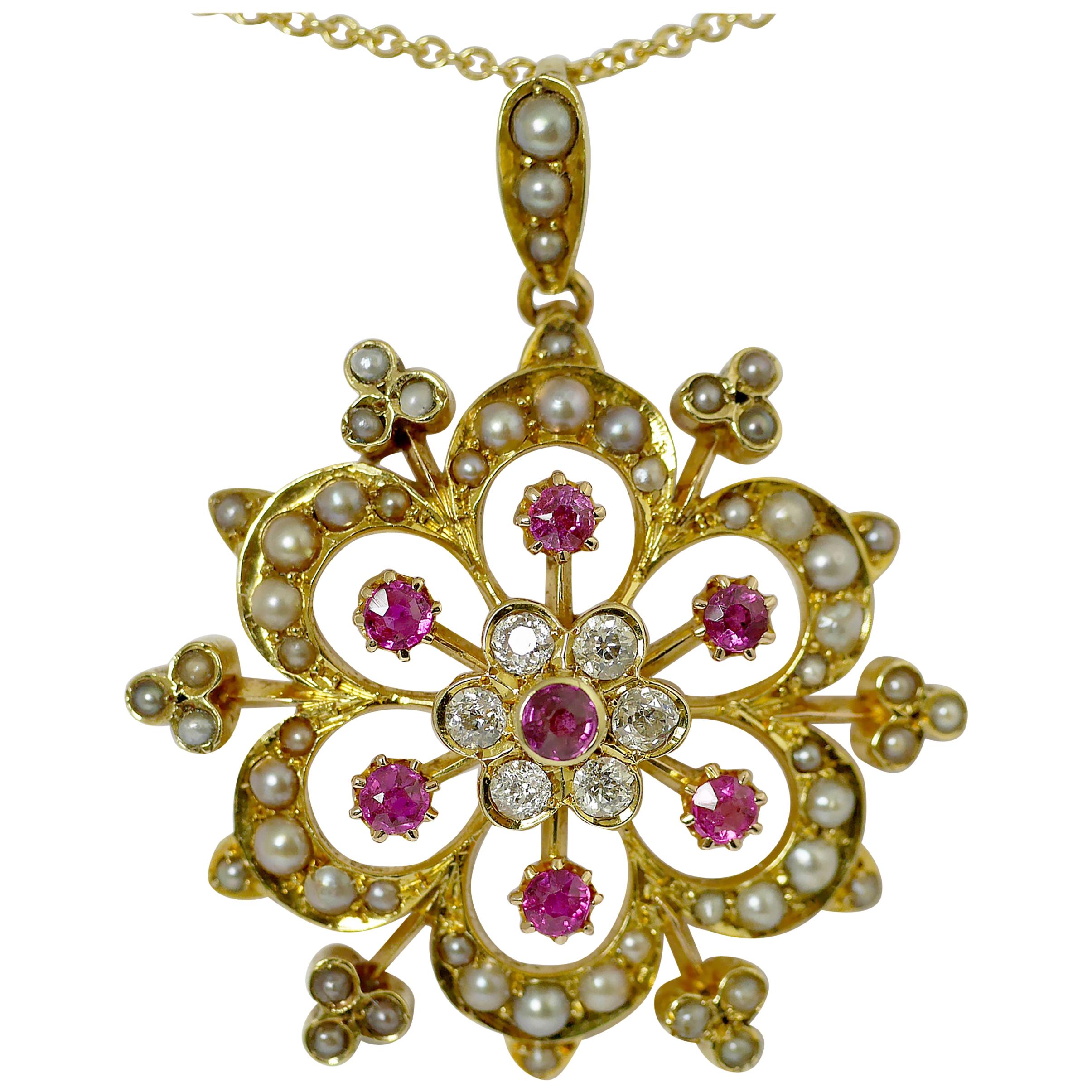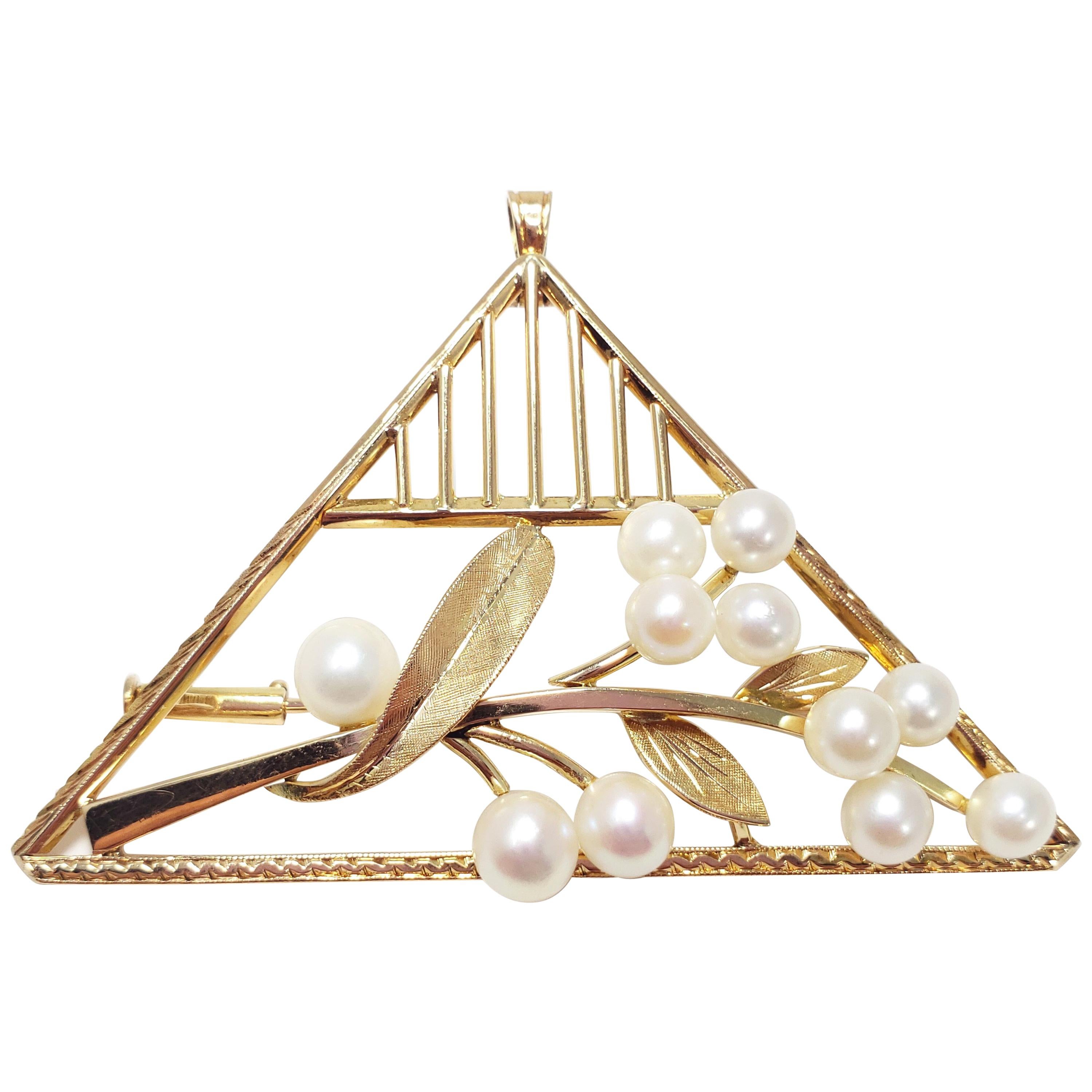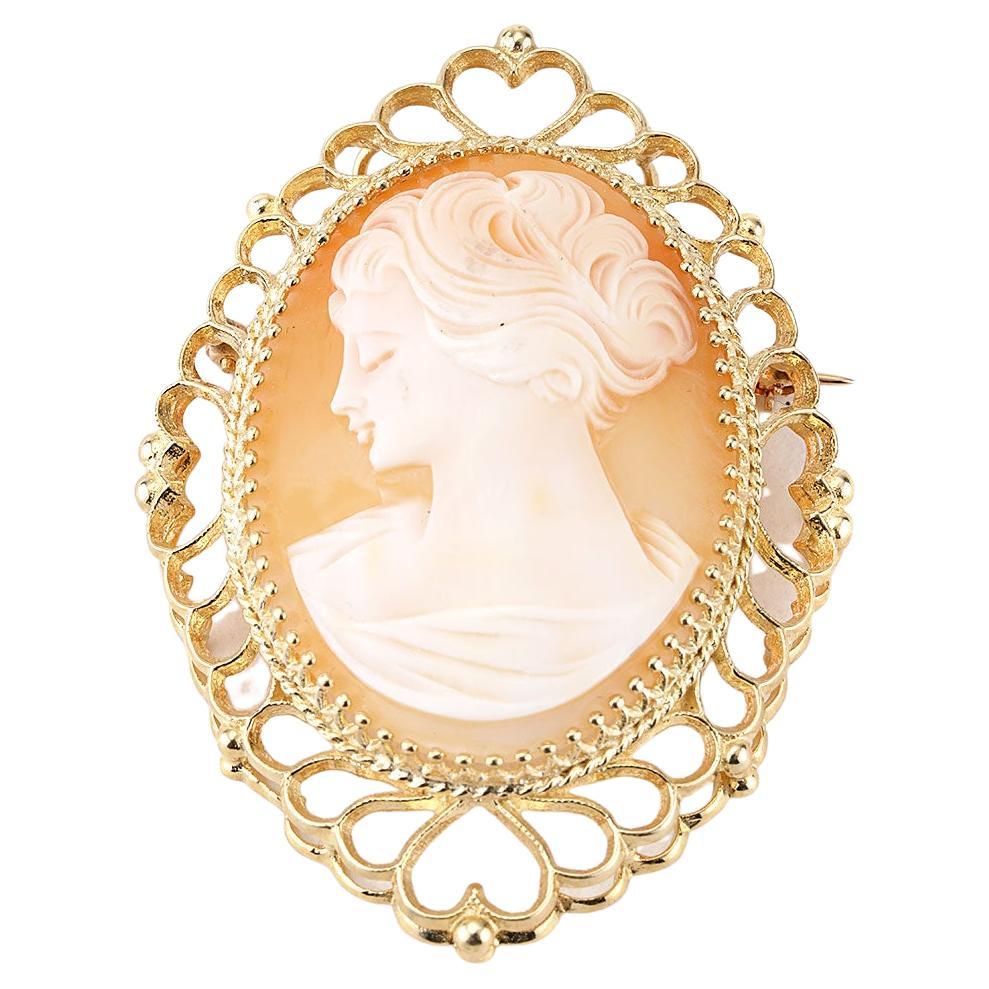Items Similar to Trifari 1940s Philippe 4PieceParure CrystalFloraMotif GoldNecklaceEarringsBrooch
Want more images or videos?
Request additional images or videos from the seller
1 of 14
Trifari 1940s Philippe 4PieceParure CrystalFloraMotif GoldNecklaceEarringsBrooch
About the Item
In the late 1940s, Trifari's French-born artistic director Alfred Philippe, who had earlier created fine jewelry for Cartier and Van Cleef & Arpels, designed this flora-motif crystal-set yellow-gold-plated parure. The rare "patent pending" four-piece set without a post-1955 copyright symbol includes a serpentine-link necklace with sliding pendant, plus complimentary brooch and pair of French-clip earrings.
With high-end jewelry crafting experience, Philippe was the first to introduce luxurious invisible settings to costume jewelry, which made his selection of high-quality crystals appear like some of the most expensive gems such as diamonds. Like this parure, such "invisibly-set diamante" pieces are among the most collectible and thus highest priced.
The large pendant features six marquise rhinestones in a sinuous leaf shape accented by four single-cut round crystals for more sparkle around the reflective twisting stem-like frame. The pendant measures nearly 1.75-inches long by 1.25-inches wide, while the diameter of its choker chain when fastened is 5 inches.
The stylized-leaf earrings each showcase three smaller marquise crystals set within a twisted heart-shape frame with three baguettes on its upright stem. Each earring measures 1.25-inches long by 0.75-inch wide.
The swirled-frame brooch depicts a stylized orchid with marquises as flowers and rose-cut crystals as buds, along with five baguettes on two curved leaves emerging from the twisted stem. It measures 1.75-inches long by 1.25-inches wide.
The brooch fastens with a safety-clasp pin on the back, where a cartouche is stamped with the crown-symbol over the capital-letter text "Trifari Pat.Pend.". The necklace fastens with a tiny fold-over clasp stamped on the bottom with the same text. The exterior of each earring clip is engraved with a crown-symbol over the brand name, while the interior is stamped "Pat.Pend.".
After the crown was added above the "T" as the brand signature in the early 1940s, it could always be found during Philippe's tenure on at least one piece in a parure that had enough space to discretely include it. This symbol pays homage to one of Philippe's most popular designs since he joined Trifari in 1930--a crown-shaped brooch.
- Creator:
- Metal:Gold,Gold Plate,Yellow Gold
- Stone:Crystal,Diamond
- Stone Cut:Mixed Cut
- Dimensions:Diameter: 5 in (127 mm)Length: 16 in (406.4 mm)
- Sold As:Set of 3
- Style:Art Deco
- Place of Origin:United States
- Period:Mid-20th Century
- Date of Manufacture:late 1940s
- Condition:Wear consistent with age and use.
- Seller Location:Chicago, IL
- Reference Number:1stDibs: LU3244219098582
About the Seller
5.0
Vetted Seller
These experienced sellers undergo a comprehensive evaluation by our team of in-house experts.
Established in 2012
1stDibs seller since 2022
9 sales on 1stDibs
Typical response time: 1 hour
- ShippingRetrieving quote...Ships From: North Adams, MA
- Return PolicyA return for this item may be initiated within 1 day of delivery.
More From This SellerView All
- 16thCentury Renaissance SilverRepousse Romantic Engagement Pendant Or HatBadgeLocated in Chicago, ILThis early-16th-Century Renaissance period silver-repousse round medallion pendant features a romantic encounter in a rural landscape between a man and smiling woman wearing European-nobility fashion, including a men's feathered hat, tights and sword. A silversmith was commissioned by this unknown man to make the pendant as a hat badge to promote his affectionate nature, which is conveyed by the welcomed gestures between the adult couple, who stand cheek-to-cheek and hand-in-hand. As there is a church in the distant landscape, this may have been his wedding-engagement announcement. It is worth noting that romantic love via marriage was a rarity before the 18th Century. The tragic romantic Italian legend of Romeo and Juliet was first translated into English for publication in 1562--several decades before Shakespeare turned it into a famous play about a deadly consequence of separating lovers. The pendant medallion is framed with a filigree-like inward-curving bezel and a flat metal backplate, while its bail enables it to be pinned as a brooch or strung on a necklace. A perfect engagement or wedding gift for a man or woman who loves antique...Category
Antique 16th Century French Renaissance Pendant Necklaces
MaterialsSilver, Gilt Metal
- Antique Amuletic DozenRockCrystals CagedRing MedievalStyle GiltBronze PendantLocated in Chicago, ILThis antique amuletic bronze framed pendant cages a dozen 7mm-diameter single-cut rock crystals that each feature a table-cut decagon crown, deep pavilion, 21 facets and uncut girdle, while the culets range from off-center to blunted. They are tightly set within four linked rings to overlap at the same angle in a sparkling single row. Seeming to retain a little of its original yellow-gold gilding on just the interior, the frame that surrounds each of the four sections of three crystals enables them to reflect pale-yellow-and-lime light when the pendant is viewed from certain angles. Suggesting French heritage, the Medieval Frankish culture in northern France made jewelry in similar segmented or openwork shapes of wheels or whorls, which were worn as gem-decorated disk-shaped brooches or gold-caged rock...Category
Antique 18th Century French Renaissance Pendant Necklaces
MaterialsCrystal, Rock Crystal, Gilt Metal, Bronze, Copper
- Antique ArtNouveau Austria Scheid RareMark Pave BlueZircon Silver Snakes BroochBy Georg Adam ScheidLocated in Chicago, ILDuring the Art-Nouveau period while German-born Vienna-based silversmith, niello master, and entrepreneur Georg Adam Scheid (1837-1921) was prospering from a related refinery busines...Category
Early 20th Century Austrian Art Nouveau Brooches
MaterialsAquamarine, Diamond, Sapphire, Zircon, Silver, Sterling Silver
- MiriamHaskell WWII FrankHess PurpleGlassFlowersGoldLeaves WiredPlasticBackBroochBy Frank Hess for Miriam HaskellLocated in Chicago, ILBeginning in 1939, Miriam Haskell asked her first designer Frank Hess to sparingly use metal in the costume-jewelry collections during WWII while war materials were needed. So their ...Category
Vintage 1940s American Baroque Revival Brooches
MaterialsMixed Metal
- 1941 ChanelRelevant American Reinad ArtDecoStyle Silver PolkaDot LargeBow BroochBy ReinadLocated in Chicago, ILIn Spring 1941 after French fashion couturier Gabriel "Coco" Chanel had stopped production of her clothing designs while she remained in Europe during the WWII era, the decades-old American costume-jewelry company Reinad began imprinting pieces in its new retail line, Chanel Novelty Co, with the script signature "Chanel". As this was prior to the use of the sans-serif capital-letter signature "CHANEL" on French-made jewelry that was commissioned by the Parisian designer, as well as before U.S.-copyright protection began in 1955, the House of Chanel that was mostly owned by the Jewish Wertheimer family of venture capitalists (who remarkably still produced Parfums CHANEL and French-vineyard wine via legal proxy while they lived in asylum in The States during the war) filed a U.S. lawsuit to demand that Reinad halt the use of its founder's famous last name. As the Werthheimers' quickly won, Reinad only produced the single seasonal collection stamped with the French brand name, and subsequently only imprinted its company name as the sans-serif capital-letter signature "REINAD" without a copyright symbol, which was different that its prior signatures dating back to its founding in 1922. When Chanel herself resumed French-made fashion production in Paris in 1953 (with Werthheimer support leading to their acquisition of all rights to her name despite her post-war eight-year exile in Switzerland due to close association with Nazis), for the first time all of her creations were signed "CHANEL" like the original packaging of the exceedingly profitable "No.5" perfume. While Reinad continued to produced costume jewelry until 1954, in the last decade of this business, the U.S. company continued to try to appeal to potential Chanel buyers by at least making Chanel-style designs. As such, owning an attractive and well-made Reinad piece can be considered a useful investment in fashion history as evidence of a little-known turning-point involving the most famous ongoing luxury-fashion business Chanel, as well as of the impact of that legal judgement had on advancing U.S. design protection for brands that later used the copyright symbol. Like early ArtDeco-style oversized heavy metallic costume jewelry by Chanel, this three-dimensional monochrome silver-alloy polkadot bow brooch imitates a pale polkadot-textured ribbon. Notably, while high-quality ribbon for styling hair or decorating clothing in a non-functional way was still an expensive accessory...Category
Vintage 1940s American Art Deco Brooches
MaterialsRhodium, Silver, Base Metal
- MiriamHaskell c1929 FrankHess Rare FurClips GoldGiltBrass 3ChainFloraBow LariatBy Frank Hess for Miriam HaskellLocated in Chicago, ILAs one of Miriam Haskell's earliest fur clips from the late 1920s, these two Russian-gold gilt mostly brass brooches by her first designer Frank Hess are tethered as a lariat by thre...Category
Vintage 1930s American Baroque Revival Brooches
MaterialsYellow Gold, Brass, Gilt Metal
You May Also Like
- Ladybug-Shaped Pendant and Brooch with Enamel of Various ColorsLocated in Rome, ITThe pendant in the shape of a ladybug with open wings, can be worn both as a pendant and as a brooch. The ladybug is decorated with transparent enamels of various colors. Its manufa...Category
Antique 19th Century Retro Pendant Necklaces
MaterialsEnamel
- Art Nouveau Diamond Opal Pendant/Brooch, circa 1900Located in London, GB18ct gold & silver set Art Nouveau Diamond Opal Pendant/Brooch dated circa 1900 Five round opals with an articulated pear shaped opal drop, very well matched with lively play of colours and iridescence in reds, greens, blues and gold. Set in 18 carat yellow gold claw collets Two main transitional cut (old mine) diamonds 0.70ct. Mix of old mine and rose cut diamonds in an 18 carat yellow gold with “silver Set” channel setting , approx 1 ct total. G/H/I, VS2-SI2. Total diamond weight: approx 1.7carats Setting diamonds in gold with a thin layer of silver, “silver set”, was a technique used in the Georgian/Victorian/Art Nouveau period as white coloured gold and platinum were not yet available. A very thin layer of silver was applied to the gold, on which the diamonds were set, to show them off to their best advantage (as the yellow would reflect and distort the white colour of the diamonds). The Art Nouveau period was a short lived but worldwide movement which reached its peak at the end of the 19th Century and the first decade of the 20th Century. It had its roots in the Pre Raphaelite and Arts and Crafts movements in Britain in the 1860’s. Artists, such as William Morris, took their inspiration from the flora and fauna of nature and rejected the mass industrialisation and mechanisation of the Victorian age. Art Nouveau continued with this theme and has a distinctive appearance with soft, curved shapes and lines and often depicted natural designs such as flowers, birds and the female form. Before the Art Nouveau period, the emphasis had been to design pieces with an emphasis on gem stones, diamonds, rubies emeralds etc. However, during the Art Nouveau period, jewellers adopted the idea of using other semi–precious stones “from nature” such as agate, garnet opal, moonstone, aquamarine and experimented with a wide variety of new techniques e.g. enamelling. The “New Art” style became a worldwide movement encompassing all disciplines of the arts, and world class artists as far afield as Gaudi with his “modernisme” architecture in Spain, Louis Comfort Tiffany in New York with objects, Galle Glass in France and the Liberty & Co Archibald Knox designs in Britain, Jugendstil in Northern Europe and Faberge in Russia. The movement flared brightly but briefly and by 1910 it was already going out of style to be replaced by Art Deco. In fitted period box. Detachable 18ct brooch...Category
Antique Early 1900s British Art Nouveau Pendant Necklaces
MaterialsWhite Diamond, Opal, Diamond, 18k Gold, Yellow Gold, Silver
- Ruby, Pearl, Diamond Victorian Pendant, circa 1850Located in London, GBVictorian Pendant/Brooch in 15 carat yellow gold with rubies, pearls and diamonds in a starburst floral design, circa 1850 15 carat gold Ceylon rubies, half pearls and diamond set. Rubies, Ceylon, natural untreated, 0.6ct total (approx) Half Pearls, natural “Gulf” Pearls...Category
Antique 1850s British Victorian Pendant Necklaces
MaterialsDiamond, White Diamond, Pearl, Natural Pearl, Ruby, Gold, 15k Gold, Yell...
- Vintage Pearl Art Deco Floral Pendant/Pin/Brooch in 14 Karat GoldLocated in Milford, DEArt deco pearls adorn this 14K gold triangular brooch/pendant decorated with floral motifs. Can be worn as a brooch, or attached to a chain and worn as a pendant. ... Tags, Marks, ...Category
Early 20th Century Art Deco Brooches
MaterialsCultured Pearl, Gold, 14k Gold
- Antique Cameo Heart Pin with Diamond in 14K Yellow GoldLocated in Chicago, ILThis antique cameo heart with diamond pin is made of 14K yellow gold. It contains a round diamond weighing 0.01 CTTW.Category
Late 20th Century Art Nouveau Brooches
MaterialsDiamond, 14k Gold, Yellow Gold
- Antique Cameo Pin and Pendant with Heart Bezel in 14k Yellow GoldLocated in Chicago, ILThis antique cameo pin and pendant with heart bezel is made of 14K yellow gold. Measurements are 2" H x 3/4" W.Category
Late 20th Century Art Nouveau Brooches
Materials14k Gold, Yellow Gold
Recently Viewed
View AllMore Ways To Browse
Van Cleef And Arpels Flower
Pair Of 1940s Pendants
Cut Crystal Pendant Pair
Heart Costume Jewelry
Van Cleef Arpels High Jewelry
Van Cleef High Jewelry
Set Of Three French Pendants
Van Cleef Fine Jewelry
Large Van Cleef
Gilt Gems
Van Cleef Arpels Leaf
Van Cleef Leaf
1920s Cartier
Van Cleef Flower Set
Swirl Stem
Most Expensive Jewelry
Cartier Curved
1920s Cartier Jewelry





